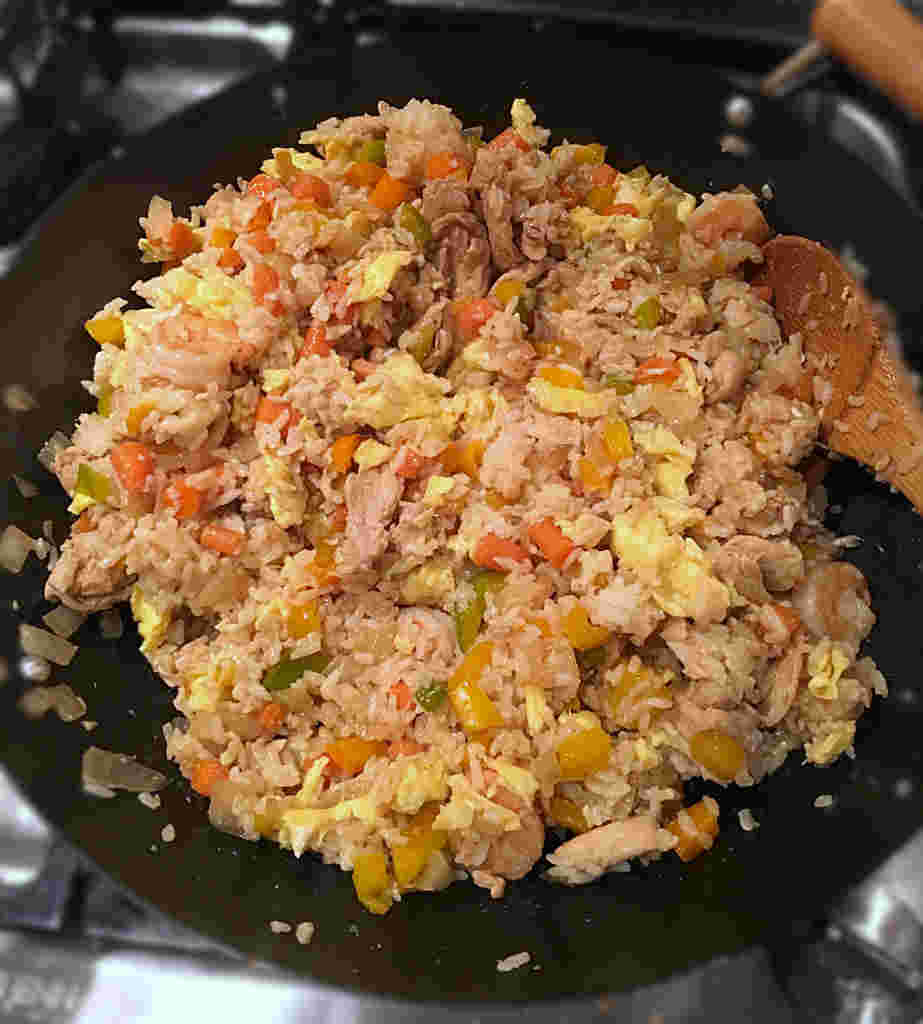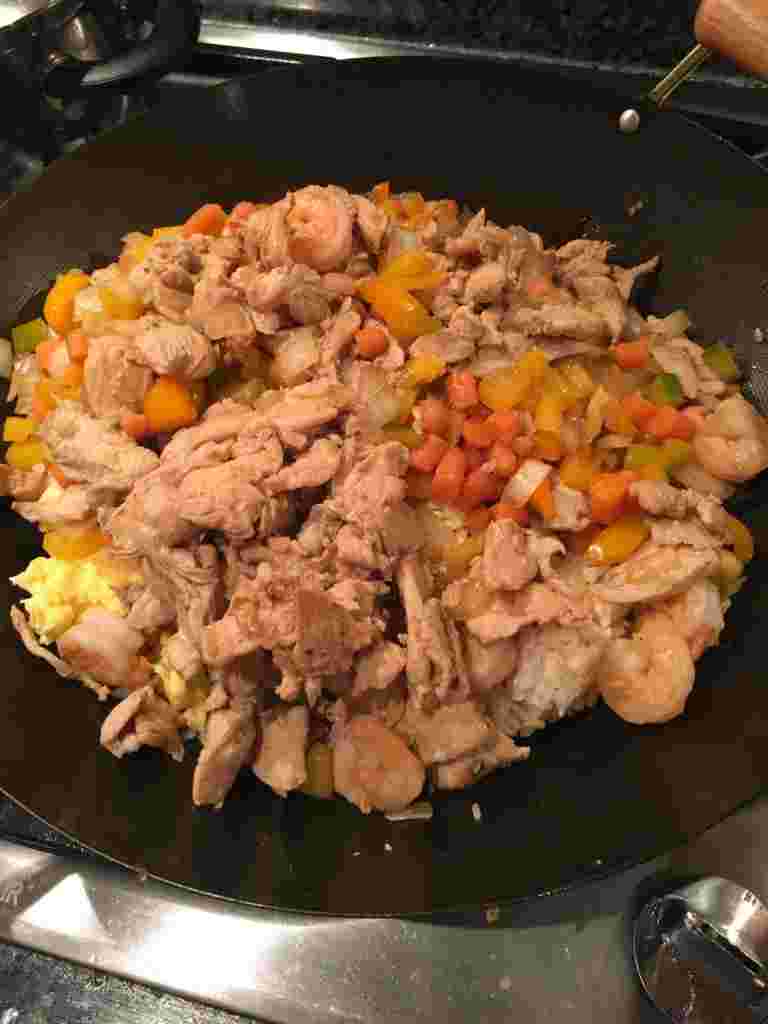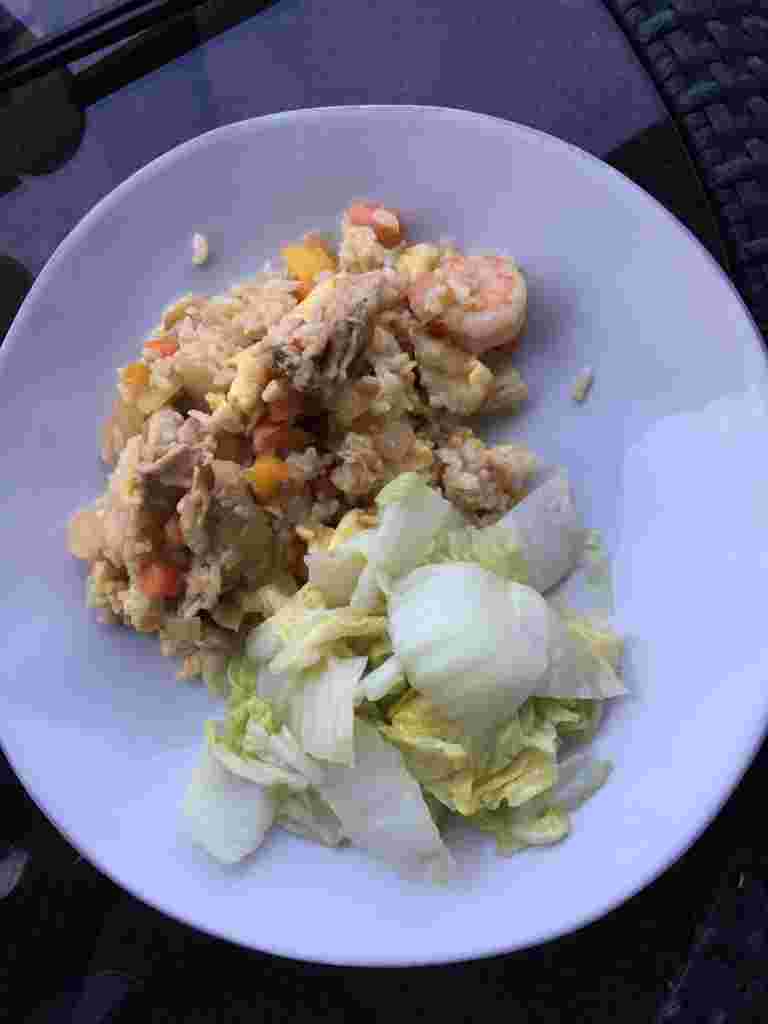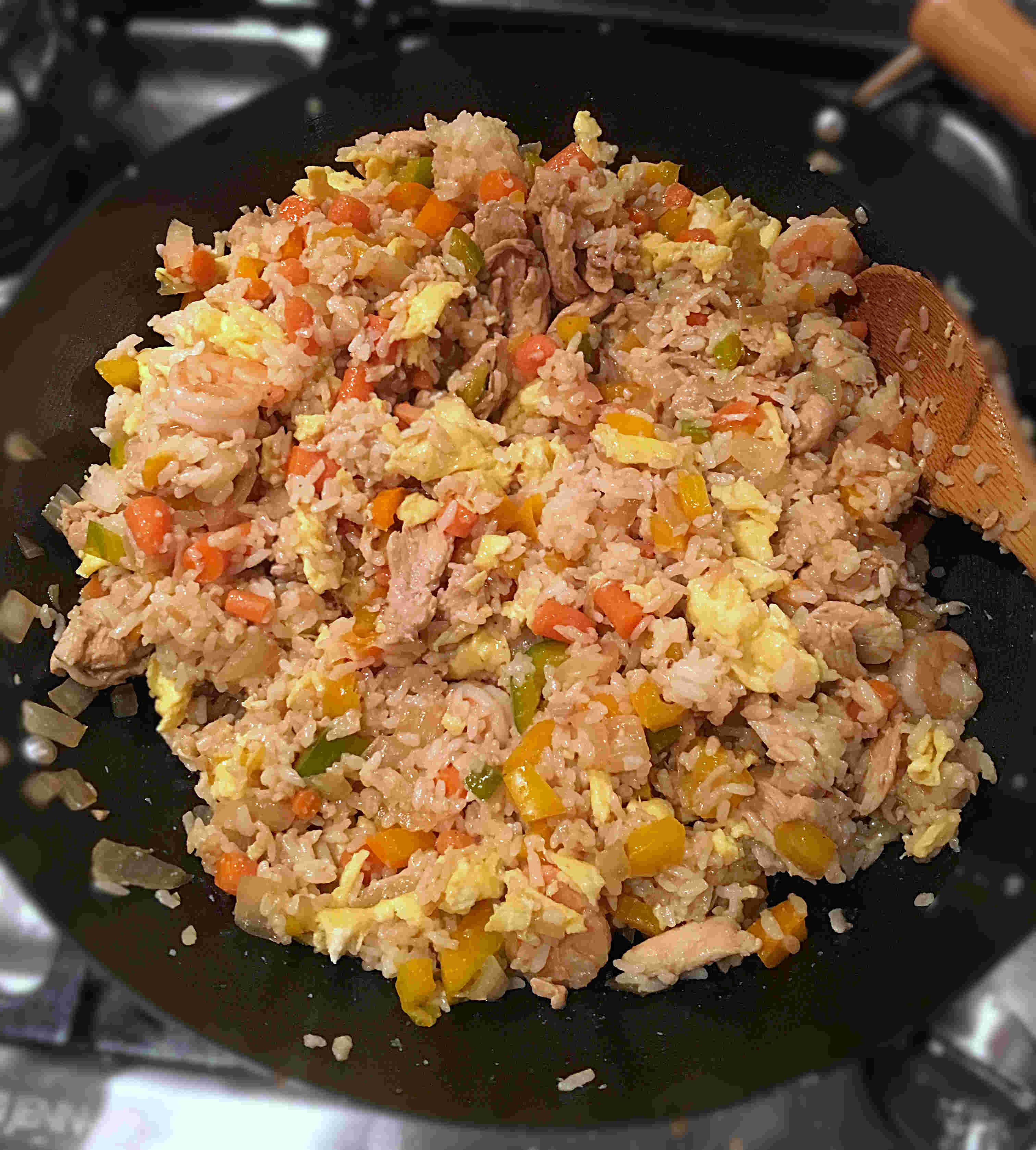
Fried rice is my comfort food, my heritage. I grew up eating egg fried rice for breakfast, which my mom would make frying up leftover white rice with heavily seasoned scrambled eggs and a handful of bright green scallions. I still remember waking up for school, hearing the sizzle of rice meeting hot oil, smelling the fragrant odors wafting from the kitchen, and eating the piping hot bowl at the kitchen table while watching my mom prepare my lunch.
Nowadays, my fried rice recipe has evolved a bit, but not much. It’s still easy to throw together, uses up any leftover vegetables you might have, and extremely forgiving. The marinade is all James, and adds a delightful, complex flavor to the meat and the rice. Secretly, I think James makes this fried rice better than me.
Now, let’s talk ingredients. If you scroll down to the recipe, you’ll see that I tell you to include a generic “2 cups of vegetables.” Is that exasperating? Please hear me out. The truth is, when I first sat down to write this recipe, it was hard! We never measure the vegetables, and we often end up using whatever looks fresh at the market or whatever’s left in the fridge. So I thought about what ingredients we both liked the most, and most frequently include. The original recipe, instead of the 2 cups of vegetables, consisted of a 1/2 pound of snow peas or sugar snap peas (or 1 cup fresh or frozen peas), 1 (8-ounce) can of bamboo shoots, and 1 (8-ounce) can of water chestnuts. However, I sat on this recipe for a long time because it didn’t feel truthful. These might be the most common vegetables we put in, but they appear in this exact combination maybe 20% of the time. The other 80% of the time, we forget water chestnuts at the store, we forget the bamboo even though they’re right there on the counter, and we have bell peppers and baby carrots that have been hanging around in the fridge foreeeeever… and so you get what you see in the pictures. Honestly, James and I make this fried rice differently almost every single time.
So then I realized – and this is a revelation I had on the bus coming home from work – why hide the exciting and empowering possibility of an eminently modifiable recipe? And who am I to dampen your creativity and your own preferences? Thus the “2 cups of vegetables,” and I think that the way it’s written now feels a lot more honest, a lot more truthful to my process. By now, James and I have made fried rice every which way – with the peas, bamboo shoots, and water chestnuts described above, with the diced bell peppers and carrots shown in the photos, or in combination with many, many other things – diced zucchini, chopped broccoli, corn, green onions. And it’s come out delicious every single time. (The onion – I kept in. Because onions are magical)
So don’t be afraid to experiment! You can also try it with beef instead of chicken. You can substitute tofu for a vegetarian option – still marinade it the same way, but leave out the fish sauce (Don’t forget to press and drain the tofu first to get rid of excess moisture!). If you’re using vegetables of different hardiness and cook times (for example carrots and bell peppers), add the hardier vegetable such as the carrot first, cook for two minutes or so, then add the other vegetable. Quantities are also not set in stone – don’t worry if you’re a bit low on vegetables, or have too much chicken. It will all come together in the end, as fried rice invariably, inevitably, uniquely does. And then let me know what you did in the comments!
A note about Shaoxing wine: it is a rice wine with a translucent amber color, made from fermented rice. It contains anywhere from 15-20% alcohol, and has a complex flavor that’s slightly sweet, spicy, and nutty. It can be drunk as a beverage – try some! Mostly, though, I use it to flavor the protein in everything Chinese I make (and probably some non-Chinese dishes too) – most often in marinades, or if I get lazy, I just add a splash of it when I’m sautéing chicken or beef. Like using red or white wine in cooking, Shaoxing wine adds a wonderful depth of flavor to the resulting dish. You can buy Shaoxing wine in any Asian supermarket, and I really hope you’ll seek some out! It’s not expensive, will last many months, and really does make a difference in Chinese cooking. There are lots of varieties, most of which are probably fairly similar. However, DO NOT buy Shaoxing “cooking wine” (like how you shouldn’t buy any other “cooking wines” to cook with either) or any Shaoxing wine that contains salt – these will be inferior, low-grade versions that taste terrible. If you can’t find Shaoxing wine, dry sherry makes the closest substitute.

As a final note, this makes an incredible amount of fried rice. We eat it with a side vegetable – some sautéed Napa cabbage or spinach, and the rice will last at least six meals. If that’s too much for you, just halve the recipe. If you do find yourself a bit short on chicken (or whatever your chosen protein is), still use all of the quantities specified in the marinade, as all that sauce will help season the final dish.
We served this with a side of sauteed Napa cabbage, and it was warm enough to eat dinner outside on the patio! A win for my sunshine-starved self AND for getting one photo in the last rays of natural light!
Total time for dinner: 1 hour 20 minutes

| Servings | Fuss Factor | Total Time | Prep Time | Cook Time |
|---|---|---|---|---|
| 6 | 3 | 1 hour | 30 minutes | 30 minutes |

Chicken and Shrimp Fried Rice
Ingredients
Fried Rice:
- 1 pound chicken breast or boneless, skinless chicken thighs
- 3/4 pound shrimp, rinsed, peeled, and deveined
- 3 cloves garlic, minced
- 2 tbsp minced or finely chopped ginger
- 1 onion, chopped
- About 2 cups vegetables of your choice, cleaned, trimmed, and diced or cut into bite-sized pieces
- 6-7 eggs, scrambled
- 5 cups cooked white rice
- Vegetable or canola oil
- Salt and black pepper
Marinade:
- 2 tablespoons soy sauce
- 2 tablespoons Shaoxing wine or dry sherry
- 1 tablespoon sesame oil
- 1 tablespoon hoisin sauce
- 1 teaspoon fish sauce
- 3 cloves garlic, minced
- Black pepper
- Pinch of crushed red pepper flakes
Instructions
-
Marinade the chicken: Cut the chicken against the grain into flat, thin strips and mix with all of the marinade ingredients. Let sit while you prep the vegetables and scramble the eggs, or at least 15 minutes.
-
Put 1-2 tbsp vegetable or canola oil into a large frying pan, skillet, or wok (make sure it is at least 4 quarts to fit all the ingredients! You can even use a Dutch oven) and heat over medium-high heat. When oil is hot, add the garlic and ginger. Cook for about 30 seconds until the garlic and ginger are fragrant. Add the chicken to the pan with all of the marinade sauce. Cook, stirring, until chicken is cooked through, about 7 minutes.
-
Remove the chicken and all the juices from the pan and set aside. Tip: keep the chicken in a large bowl, so that you can add the other cooked ingredients to this bowl later.
-
Heat 1-2 tbsp of oil over medium heat in the pan. Add the shrimp and season with salt and pepper. Cook, stirring, until the shrimp is just pink and cooked, about 2-4 minutes, depending on shrimp size. Transfer to the chicken bowl.
-
Add 1-2 tbsp more oil to the pan. Don’t worry if there’s chicken or shrimp bits stuck onto the pan. The moisture from the onions and vegetables will deglaze the pan. Add the onion, some salt and pepper, and cook over medium-high heat until translucent, about 5 minutes. Add the vegetables, staggering them in 1-2 minute intervals if some are hardier than others. Cook until vegetables are tender, then scoop up vegetables and set aside. You can place them in the same bowl as the chicken and shrimp. I do this, and then try to toss the shrimp up so that they’re not cooking under the hot vegetables. It seems to work okay, and doesn’t result in overcooked shrimp. If you’re worried, use a separate bowl for the vegetables or the shrimp.
-
Cook the eggs. If the pan you’re working with isn’t non-stick, I would use a separate nonstick pan to cook the eggs. You’ll have an additional pan to wash up, but it’s just easier and less fuss. Heat 1-2 tbsp of oil in the pan over medium-high heat, then add the eggs. Season with salt and pepper. Scramble until the eggs are cooked, then transfer to the bowl with the chicken and vegetable mixture.
-
In the original pan, heat 1-2 tbsp of oil over medium heat, and add the rice. Season with a few dashes of soy sauce – just swirl it loosely over the rice like you would drizzle chocolate sauce on ice cream. Toss so that all the rice is seasoned. The rice might sizzle and stick to the bottom of the pan – don’t worry! Just continue to toss and fry with the soy sauce, so that the rice itself acquires some seasoning. You’ll add the other ingredients soon enough, and the chicken and vegetable juices will magically mix with the rice to make an amazingly flavorful combination.
-
Add the chicken, shrimp, vegetables, and egg into the pan with the rice, and turn heat down to medium-low. Toss well to combine. Taste and add more salt, pepper, or soy sauce if needed. I like to finish my fried rice with lots of dashes of white pepper and a drizzle of fish sauce and sesame oil (again, a light drizzle, like topping ice cream), but this is optional. The sesame oil will give it a nice earthy, umami taste. The fish sauce – although it smells terribly fishy – actually adds a nice tang and saltiness to the resulting dish. White pepper is my absolute all time favorite pepper. Feel free to scoop out a small bit of rice and experiment with seasonings!
Notes:
I tend to prefer short grain rice in my fried rice, because I like my fried rice on the dense and chewy side, but if you want a fluffier, lighter rice dish, you can easily substitute basmati.
About salting and oil: yes, the instructions are correct! A lot of salt and a lot of oil are what make restaurant fried rice so darn good. Be sure to salt all of the ingredients as you cook them. It’ll draw out the flavors of the individual ingredients, and make the finished product that much tastier. Same with the oil – yes, it’ll feel like you’re using a lot of oil, but remember that this makes an enormous amount of fried rice. The finished product won’t be too oily, I promise. The more oil you add, the more decadent and “fried” your resulting dish will taste.
About cooking the ingredients separately: Yes, it’s a pain, but doesn’t really take that much additional time, and doesn’t add too much to the dirty dish count, as you can spoon up all your cooked ingredients into one large bowl. If you’re feeling lazy, you can cook the chicken and shrimp together (add the shrimp after the chicken has been cooking for about five minutes), although this always runs the risk of overcooking the shrimp.








